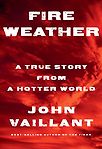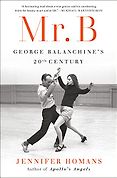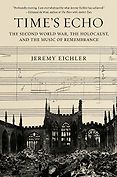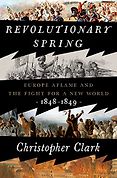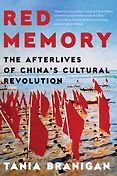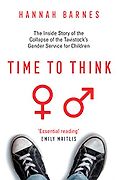For people who haven’t come across the Baillie Gifford Prize for Non-Fiction before, could you start by telling us what kind of books you, as judges, were looking for?
We aren’t looking for any one type of book, it doesn’t have to be (say) memoir or about the news—about war or climate change. What we were going for—the criteria which we established right at the outset—were originality of topic and of approach. Has someone gone for a different, interesting way of getting into a subject? That then leads into how well it is executed, which is a different way of saying how well it is written.
Another criterion was relevance. Is this book something we all should be thinking about now? ‘Now’ could be quite long. It doesn’t have to be all about Gaza. It could be about long-term or deeper things that are playing out that we’re living through.
Also, very crudely, how enjoyable is the book? Or entertaining, even? For instance, on the longlist, we had a wonderful book called The Wager. The author certainly made a decent case that the book was exploring the early period of globalisation, empire, and colonisation, and the economic and social underpinnings of that. But it was also a great adventure story, about a group of British ships that set sail as a diversionary tactic in a bigger conflict with Spain. One ship, the Wager, which was cursed almost from the start, had a very strange crew of people, including Byron’s grandfather on it. They were shipwrecked in South America, and it’s an extraordinary story of rebellion, mutiny, and—almost—cannibalism and how they somehow get home.
If you take all those things, no single one is going to trump everything else, but it’s how they all interplay.
Let’s start with Fire Weather by author and journalist John Vaillant. This is a climate change book, about a wildfire that wreaked havoc in 2016 in Alberta, Canada. Could you tell me a bit about the book and what you liked about it?
This book comes out of that fine North American tradition of nonfiction writing—a deeply researched and meticulously told account of a real event. It’s about a fire that happened up in the subarctic region of Canada, which is, by definition, very remote.
It’s a very hard place to earn a living and it tells you a lot about human beings that tens of thousands of people have moved up there to work in the tar sands industry. This is a part of the oil industry that should be marginal because it’s very difficult to get the oil out. You have to expend huge amounts of electricity and natural gas to lift the sands and then to melt and render out the oil. That, in itself, is a remarkable thing.
Fire Weather tells the story of what happens when everything goes wrong and the unthinkable happens. It’s the boreal forest up there, and forest fires are nothing new—they happen quite regularly. It’s a way that nature cleans up a bit, to put it simplistically. But this fire in 2016 went completely out of control. There are various reasons for that, but it points to a bigger issue around changes in the climate. The author gives you a very vivid account of that extraordinary event, which affected 90,000. It destroyed much of this place, Fort McMurray, and made a lot of people homeless. 2,400 structures were destroyed and 1,000 more were damaged.
The physics he describes is extraordinary. The fire gets up to a level where nothing can resist it. Things that you would think are indestructible just go. Metal goes, solid structures go. It’s out of control. Some of the almost poetic parts of the book are how he describes fire as this thing in itself: how it operates on its own laws, and what it needs to keep going. That includes oxygen, of course, but also everything to do with fossil fuels. It is not just the tar sands or bunkers of petrol: much of our houses is now made of things that come from fossil fuels. Plastics are the obvious one, but there are lots of others. Once a fire gets going, these are just kindling and further fuel for the fire.
It’s one of those stories that goes from utterly focused, diligent reporting—minute-by-minute tracking people as they’re fleeing from their homes and trying to take their pets and the house is blowing up—through to the bigger picture of the oil industry, going to the most remote places on earth to engage in the most insanely arduous processes to extract oil and pump it out because there’s some money to be made. It’s about all the political dynamics around that, who is in charge of those industries in that part of the world and then, into the bigger picture of the environment. It’s about the economics, the environmental state and the changes that we’re living through.
It covers this extraordinary canvas. It makes you think about an issue that we hear a lot about and puts it into a very real moment.
Judging from the reviews, it’s also very gripping.
Totally. That comes out of that tradition I mentioned. It’s that intense detail—all the eyewitnesses’ quotes feeding in. There’s the blow-by-blow account of what the local radio station is putting out as they themselves are facing the decision of whether to keep broadcasting or to make a run for it. It’s very alive.
Let’s move on to the next book. This is Mr. B: George Balanchine’s Twentieth Century by Jennifer Homans. I always associate the name Balanchine with The Nutcracker because when I lived in New York, I would go and see that version of the ballet at Christmas. Tell me about this book.
This is a book about George Balanchine, the great choreographer. This book slightly snuck up on a few of us because ballet is not something I’m that interested in: I spent time taking our daughter to ballet classes for several years, but it’s not an area I’m totally familiar with.
It’s a big book. It’s a biography of a man who almost walks with the 20th century, so you get all that history. Balanchine was of Georgian heritage and grew up in Tsarist Russia. Early on, he was selected to go into the Imperial Ballet School, so he’s on that track. Then, the Russian Revolution happens and everything falls into turmoil on all fronts. There’s a lot of hunger, violence, and chaos.
Interestingly, the Communists decided that their approach to culture was not going to be totally avant garde and progressive. They assume a lot of the culture from the imperial period but give it a people’s interpretation. The ballet becomes what it became throughout the Soviet decades—a showcase. Within the Soviet system, a very elitist high art form was adopted.
Balanchine parts company with that, as a young man, as do a lot of others. They come on a wandering journey via Berlin and Paris and London. So many of those Russian emigres—Nabokov, Diaghilev, Stravinsky—get out of Russia.
Balanchine eventually winds up in America, where he meets well-connected benefactors and cultural managers. They feel that American ballet hadn’t yet achieved the same level of institutional high standing as Europe. They have the ambition to rectify that and are keen to use people like Balanchine and others who had come over to the US. Eventually, Balanchine sets up the New York City Ballet Company, which, in effect, becomes the country’s national ballet.
It is an extraordinary story with lots of incidents. It covers what he did through the decades in the States. In his final years, a very moving period, he goes back to the Soviet Union as a Westerner. He’s still got family there, and we see how he negotiates that.
The parts I read were quite magical, which fits: as a choreographer, Balanchine was selling magic.
The book works, I think, because it’s written by a ballet critic. Dance is a difficult thing to write about. Homans manages that while putting it within this extraordinary context. It’s a particular cultural history of the 20th century. Even though it’s quite long, it is written in a way that carries you with it.
Next up is another fascinating and quite unexpected book. This is Jeremy Eichler’s Time’s Echo: The Second World War, The Holocaust, and The Music of Remembrance. Tell me about this one.
This is one of the most ambitious books that I’ve read recently. Jeremy Eichler looks at four composers—Strauss, Shostakovich, Britten, and Schoenberg—who were witness to some of the most shocking events of the 20th century. These are events like the Holocaust, the terror in the Soviet Union, and the bombing of Coventry and he looks at how they are reflected in their music. How did these composers incorporate them or address them through music?
The book then looks at how music can be a medium of memory. These composers were there, they were able to have an immediate reaction. By nailing it, we, coming a lot later, can get close to those events by listening to the music. In essence, the music is almost like a time portal: it cuts through the decades—centuries, even, by now—to bring you back to an experience, which, in these cases, was truly terrifying.
Eichler is a North American music critic. This book is a life’s work and draws on years of research, of knowledge, of thinking. It’s told in a way that is very learned. It tries to move in various registers and tell the story as you go along.
We see the siege of Leningrad via Shostakovich. The Benjamin Britten sections cover everything from the obliteration of Coventry to his own experience of going into the concentration camps when they were liberated. Britten was able to attach himself to a cultural corps that was going in to witness what was happening.
It’s a remarkable book because it challenges you to think about how you remember things, and where memory lives. Coming at it through the aural sense—how you hear—is quite original. The book is throwing an idea at you that you didn’t necessarily expect.
And, as you’d expect from a book shortlisted for the Baillie Gifford Prize, he draws you in right from the beginning. It opens with a description of Goethe’s mythical tree at Buchenwald Concentration Camp.
Yes. What you learn about European cultural and intellectual history along the way is quite something.
Next up we have a history book about the 1848 revolutions. This is Christopher Clark’s Revolutionary Spring. It’s quite a long book, so not one to go for if you want a quick summary.
Christopher Clark is one of the great historians of our moment. He writes very elegantly and smoothly, so even though it’s long, you could read shorter books that would be more of a struggle. You might instinctively lean towards saying it’s a traditional big history book. He takes a topic and goes at it to tell you a big story. He’s very learned, has read everything and thought about everything.
He does find original avenues of approach to events that, he claims, are largely forgotten. If you studied 1848 at school, you might have a vague notion that Marx reflected on it. Other than that, it’s not really in the canon: it’s not the French Revolution, or the First or Second World War. It’s somehow lost. He’s saying, ‘Hang on! This was an extraordinary moment because across pretty much the whole of Europe, there was a form of uprising or revolution.’
It happened in spring, they’d fallen out with each other by the summer, and by the autumn the counter-revolution kicked in and the whole thing was “over.” But that doesn’t mean there’s nothing to see here. It had profound influences that we still feel today.
Clark goes back and describes—and I thought these were the most interesting parts of the book—the Europe of the early and mid-19th century. What you see there are lots of conflicting movements and tides—some of them quite dynamic, some of them quite static—driven by industrialisation, the collapse of the old order, new ideas about how society should be organised etc. Something is bubbling up. It’s not one thing: lots of things are interacting that are quite complex.
He draws an analogy and asks, ‘Does any of this sound familiar?’ In the world we’re living in now, there are these new developments. In our age, a lot of it is around technology and what that is doing to all our societies, from personal relationships to whether you’re going to have a job to who has the most money.
He organises that all quite well into a big picture, then tells you about the revolutions themselves as you go through the year. He then reflects on what their legacy was. He says that every country in continental Europe was, in some form, reconstituted after that event and re-tuned for the modern era.
It’s a work of history that drags your perspective to somewhere you didn’t expect. It causes you to pause. Where Christopher Clark is really good is that he brings to life that world as a historian. He goes through the annual bills for a weaver in Lyon, and says, ‘This is how much you got paid. This is how much your rent was. This is how much bread cost.’ You realise the social distress for many people at a very basic level: something was going to give.
We’re now at Red Memory by Tania Branigan, about the Cultural Revolution. I’ve read quite a few memoirs of the Cultural Revolution. It even featured in a Chinese crime novel I was reading recently. I’m interested to hear what this book brings to the picture.
Yes, it’s not totally uncovered territory, and you could also point to important works by historians like Frank Dikötter.
Tania Branigan was a journalist for The Guardian in China and what she realised is that there was this spectre she kept encountering, which was the unspoken legacy of the Cultural Revolution. It was obvious everyone knew, but no one wanted to dwell on it, or talk too much about it. It was a mass, collective experience, so most people she was encountering had either been through it themselves or their parents had been through it. Essentially, it has deformed Chinese society.
The book goes right through to President Xi, whose father had been a big wheel in the Communist Party. He then fell from favour and was persecuted in the Cultural Revolution, as was Xi himself. Now he’s behaving with ever-increasing authoritarian tendencies, which is quite strange.
What Tania Branigan does very elegantly and assuredly is tell the story in a very human way. We meet people, and then she goes back and tells the whole story. The violence is appalling—it’s just unbelievable. Schoolchildren were kicking their teachers to death. It’s about how everyone has buried that or reconfigured the story to tell it differently.
We all felt that the book was very well written, very vivid, and pertinent to China which is, obviously, one of the big stories of our time. There are many ways to understand China, and this is one way to understand Chinese society today, if you’re looking at it from the outside with not a lot of knowledge. You come away learning a lot about it.
At a broader level, again this book is about memory, trauma, and history. Look at what’s going on right now. How do you deal with evil behaviour that has happened in your midst? You may even be responsible for it. It might be within your family, or it’s your next-door neighbour.
The last book to discuss on this year’s shortlist is Time to Think: The Inside Story of the Collapse of the Tavistock’s Gender Service for Children, by Hannah Barnes. Could you explain what this book is about, bearing in mind that some of our readers aren’t in the UK and might not have heard of this clinic.
The Tavistock Clinic was—it’s in the process of being shut down or reconstituted—a pioneering institution for the study and treatment of gender dysphoria. When it was set up, it was if not unique, one of very few places where these treatments were offered for children.
Hannah Barnes is a journalist with BBC’s Newsnight. In this book she tracks the story of how an institution that was set up with very good intentions to do necessary work lost the run of it, you might say. Things went awry to the point where it was overwhelmed by demand. That may have been a significant factor in why they then started to attract criticism about treatments not being appropriate, in terms of who was getting them, and how when certain things were red flagged—that maybe certain treatments weren’t appropriate or had gone wrong—that there wasn’t the mechanism within the system to acknowledge and address that. There was a culture of covering up because the clinic was operating in a societal context where the whole issue around gender and transitioning had become very charged, with deeply and fervently held views in the debate.
This is not an easy subject to write about, in the UK or anywhere else, but particularly in Britain at the moment. There have been a number of books that have sought to address the trans issue, coming at it from different perspectives. Some are pro and some are more critical and, very quickly, the authors and the books attract quite savage criticism.
Barnes manages to give a very calm, well-researched account. She’s not taking sides about any policies, but she is talking about institutional failure. It’s about how you can start in a good place and how things can go wrong. The management breaks down and then there are bad consequences for everyone, both for the patients and for the clinic which has effectively been shut down. The services will still be available, but it’s been reconstituted and it will be organized differently.
Beyond the trans issue, the book tells you something about the inner workings of the NHS, one of the biggest institutions in the world that employs well over one million people.
It’s an extraordinary beast and running it must be a nightmare. Recently, there have been a number of scandals in Britain. There’ve been terrible stories about neglect or even killing of children. Everyone goes, ‘How could this happen?’ With this book, you can see how within this complex organisation, the management of certain things gets lost. It’s too unwieldly, almost. On a micro level, Barnes illuminates how money and resources and attention get divvied up. It’s a complicated piece of journalism to get right. The book is quite a brave endeavour, in that it could attract quite a lot of criticism. She manages it by not being polemical. She shows her workings. There’s lots of data, people on the record, and documents that she puts out there.
Interview by Sophie Roell, Editor
November 15, 2023. Updated: January 23, 2024
Five Books aims to keep its book recommendations and interviews up to date. If you are the interviewee and would like to update your choice of books (or even just what you say about them) please email us at [email protected]
Five Books interviews are expensive to produce. If you've enjoyed this interview, please support us by donating a small amount.

